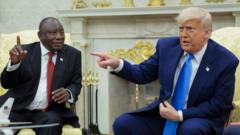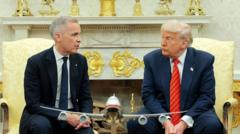Experts caution high costs and logistical challenges, yet emphasize its potential to enhance national security.
**Can Trump’s 'Golden Dome' Protect the U.S. from Advanced Missile Threats?**

**Can Trump’s 'Golden Dome' Protect the U.S. from Advanced Missile Threats?**
In a bold move, Donald Trump proposes the Golden Dome, a next-gen missile defense system, to counteract emerging threats like hypersonic weapons.
The Trump administration is gearing up for an ambitious defense initiative dubbed the "Golden Dome," aiming to bolster U.S. missile defenses against increasingly sophisticated threats. Highlighting scenarios that could result from a nuclear electromagnetic pulse (EMP), experts emphasize the urgency of upgrading America’s aging defense systems.
Security researcher William Fortschen suggests that an EMP could be devastating, causing critical failures across the nation’s infrastructure. With the emergence of advanced weapons from global powers like Russia and China, Trump advocates for the creation of this next-generation missile shield, initially referred to as the "Iron Dome for America."
Missile defense expert Patrycja Bazylczyk indicates that current systems are primarily designed for intercontinental ballistic missiles (ICBMs), rendering them inadequate against newer, more dynamic threats such as hypersonic missiles and systems capable of global strike capability from space. The Golden Dome would aim to address these threats by incorporating multiple defense layers across land, sea, and space, building on existing technologies.
Despite the ambitious goal, specifics on the system remain sparse. During a recent White House address, Trump claimed the system would be in place by the end of his term, with an estimated cost of $175 billion, including a $25 billion initial investment. This estimate starkly contrasts with the Congressional Budget Office's projection of up to $542 billion over 20 years for necessary space-based systems.
While Trump's proposal draws upon Israel's successful Iron Dome system, experts warn that the challenges of implementing such advanced defense technology are tremendous. Incorporating various systems to create an interconnected command and control infrastructure is critical but complicated.
Experts like Dr. Stacie Pettyjohn of the Center for a New American Security note the stakes involved, asserting that existing U.S. defenses are inadequate to counter the significant missile capabilities of adversaries like Russia and China. The Golden Dome initiative, while potentially effective, may open the door to an arms race as competitors respond with their strategies to bypass its defenses.
As the concept advances, discussions around its implications continue. Proponents argue that enhancing defense mechanisms could deter potential attacks, reinforcing national security. Even a partially effective system might mitigate nightmare scenarios associated with missile threats, providing a sense of security amidst rising global tensions.
Despite skepticism about feasibility and cost, support for the Golden Dome persists, with some seeing it as a vital step toward modernizing U.S. defense capabilities for a rapidly evolving geopolitical landscape.
Security researcher William Fortschen suggests that an EMP could be devastating, causing critical failures across the nation’s infrastructure. With the emergence of advanced weapons from global powers like Russia and China, Trump advocates for the creation of this next-generation missile shield, initially referred to as the "Iron Dome for America."
Missile defense expert Patrycja Bazylczyk indicates that current systems are primarily designed for intercontinental ballistic missiles (ICBMs), rendering them inadequate against newer, more dynamic threats such as hypersonic missiles and systems capable of global strike capability from space. The Golden Dome would aim to address these threats by incorporating multiple defense layers across land, sea, and space, building on existing technologies.
Despite the ambitious goal, specifics on the system remain sparse. During a recent White House address, Trump claimed the system would be in place by the end of his term, with an estimated cost of $175 billion, including a $25 billion initial investment. This estimate starkly contrasts with the Congressional Budget Office's projection of up to $542 billion over 20 years for necessary space-based systems.
While Trump's proposal draws upon Israel's successful Iron Dome system, experts warn that the challenges of implementing such advanced defense technology are tremendous. Incorporating various systems to create an interconnected command and control infrastructure is critical but complicated.
Experts like Dr. Stacie Pettyjohn of the Center for a New American Security note the stakes involved, asserting that existing U.S. defenses are inadequate to counter the significant missile capabilities of adversaries like Russia and China. The Golden Dome initiative, while potentially effective, may open the door to an arms race as competitors respond with their strategies to bypass its defenses.
As the concept advances, discussions around its implications continue. Proponents argue that enhancing defense mechanisms could deter potential attacks, reinforcing national security. Even a partially effective system might mitigate nightmare scenarios associated with missile threats, providing a sense of security amidst rising global tensions.
Despite skepticism about feasibility and cost, support for the Golden Dome persists, with some seeing it as a vital step toward modernizing U.S. defense capabilities for a rapidly evolving geopolitical landscape.




















